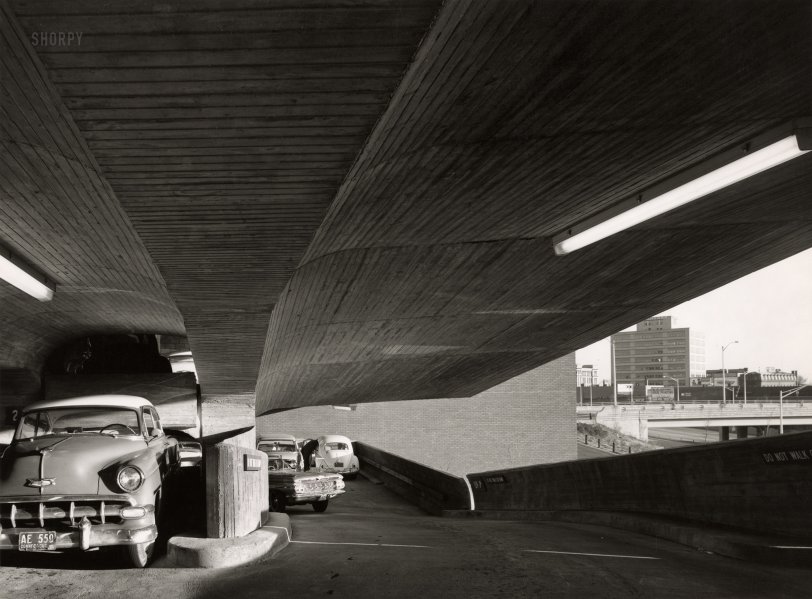


Framed or unframed, desk size to sofa size, printed by us in Arizona and Alabama since 2007. Explore now.
Shorpy is funded by you. Patreon contributors get an ad-free experience.
Learn more.

- Air Quality?
- Sojourner Truth riot
- None were so blind(ed)
- The less famous sister
- Good ol' days?
- Rise and Fall
- Goo Goo Ga Joob
- Ticket Retention
- Not the only one
- Vagaries of War
- Killed by Amtrak
- Back to the Future
- Wanted --
- If you can't stand the light
- Centralized Traffic Control, I believe
- What's really happening
- Heckuva remote control!
- Sometimes — Things Go Bump!
- I SEE THE LIGHT
- Union Switch and Signal Company
- Get That Light Out Of My Eyes
- Eggs. Eggs. Eggs. The Egg Man is Here!
- Foreboding caption
- Famous Hollywood faces
- Not just S&P
- re: Those things in the jar
- Up In Smoke
- Medical Smoking
- Quick fix
- A Quink Comment
Print Emporium
Car Haven: 1963

1963. "Parking garage, New Haven, Connecticut. Interior looking down ramp. Paul Rudolph, architect." Photo by Ezra Stoller. Paul Rudolph Collection, Library of Congress. View full size.
Stacked Board formwork
Brutalism at its "finest". Note that the concrete is given its texture, rhythm and direction from the naked, unfinished boards stacked together as a concrete form. The wet concrete flows up against the boards and takes on the grain, not-holes and records the spaces between the planks.
He could have used plywood forms, or smooth, non-textured formwork. The garage would have had a vastly different feel from those techniques. He also uses the formwork to create flat ceilings, arched barrel vaults and arched beams that go from column to column, as if this were a great medieval cathedral. Well, it was america in the 1950s and what other use did we have for religious architecture? Can we stand this stuff today?
Function and Form and Flair
The Temple Street Garage of New Haven, a fine example of urban architecture that deftly blends function and form. Architect Paul Rudolph said, "I wanted to make a building which said it dealt with cars and movemement. I wanted there to be no doubt that this is a parking garage."
While most parking structures are unremarkable stacks of concrete slabs, Rudolph molded into this building gracious curves that invoke the motions of vehicles on superhighways.
Still There
This looks like the Temple street garage in New Haven CT (for some silly reason Google Street View shows this in the dark of night). That tall building at the right is the New Haven Railroad office building, now a board of education office building.
Little details
A couple of things are revealed about both Chevies in the photo. The '54 is a stick shift otherwise you'd see the PowerGlide gear shift pointing at the 1:00 position behind the steering wheel. The '59 is an Impala by trim and a 283 by engine choice because of the "V" on the hood--a 348 would have cross-flags above the "V". The '55 Hudson and VW Bug say "me too"!
[The “'55 Hudson” is a 1957 Rambler. -tterrace]
All new all over again
Between these two Chevys, '54 on left and '59 on right, are huge differences in design (compare the hoods), and in between those were three vastly different designs, the '55-56, then classic '57 and my fav of all, the '58. Each very different in design and mechanicals. Those were the days of great new model rollouts.
[The "Tri-Five" Chevrolets of 1955-56-57 were basically the same car with different sheet metal. - Dave]
Car heaven
Such a highly evocative photograph. The dramatic lighting on the car on the left is downright cinematic, and the detail in the concrete of the formwork is endlessly fascinating, so wood-like in appearance. The swooping form of the overhead structures is lovely, and captured to maximum effect with the camera angle. Finally, those are the cars that populated the environment of my 6-year-old self, in that year, and seeing them casually parked and coming up the ramp is like some time-travel dream. Thank you, Ezra Stoller, whoever you are. You remind me in the best way of Samuel Gottscho.
[His obituary. - Dave]
Mr. Stoller was not merely a documenter but also an interpreter of buildings, translating an architect's three-dimensional vision into two-dimensional abstract compositions that had a sweeping beauty of their own. Famous for his ability to capture a building from just the right angle and in just the right light, he was often commissioned by the world's leading architects, who spoke, in hopeful tones, of having their creations "Stollerized."
























On Shorpy:
Today’s Top 5